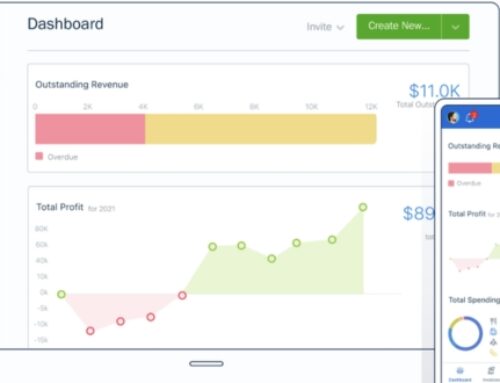Overview of FreshBooks:
Introduction to FreshBooks as Cloud-Based Accounting Software:

FreshBooks is a cloud-based accounting software designed primarily for small businesses and freelancers. Being cloud-based means that users can access their financial data from anywhere with an internet connection, making it highly convenient and flexible. The software is known for its user-friendly interface and ease of use, making it accessible even for those without extensive accounting knowledge.
Key Features and Functionalities:
- Invoicing: FreshBooks allows users to easily create professional-looking invoices. Automated invoicing features save time and ensure timely payments.
- Expense Tracking: Users can track business expenses and categorize them for better financial management.
- Time Tracking: Ideal for service-based businesses, FreshBooks includes a time-tracking feature to monitor billable hours accurately.
- Reports and Insights: The software provides various reports and financial insights, helping businesses make informed decisions.
- Multi-Currency Support: FreshBooks supports multiple currencies, making it suitable for businesses with international clients.
Evolution of FreshBooks and Its Impact on Financial Management:

FreshBooks has evolved over the years, incorporating user feedback and technological advancements.Continuous updates and improvements reflect a commitment to staying relevant and meeting the changing needs of businesses. The impact on financial management is significant, streamlining processes and providing real-time insights to enhance decision-making.
Comprehensive Analysis:
Financial Statements Examination:
Review of balance sheets, income statements, and cash flow statements:
This involves a thorough examination of the company’s financial statements to gain insights into its financial performance. The balance sheet provides a snapshot of assets, liabilities, and equity, the income statement reflects revenues and expenses over a period, and the cash flow statement tracks the flow of cash in and out of the business.
Identification of any anomalies or discrepancies:
The analysis involves identifying any irregularities or discrepancies in the financial statements. This could include unusual spikes or declines in revenue, unexplained changes in expenses, or inconsistencies in the balance sheet.
Tax Planning and Compliance:

Assessment of tax liabilities and obligations:
This step involves calculating the company’s tax liabilities based on its income and ensuring that all applicable taxes are considered. It also involves a review of potential tax obligations to prevent any surprises during tax filing.
Implementation of tax-saving strategies:
After assessing tax liabilities, the focus shifts to identifying and implementing strategies to minimize tax burdens legally. This might involve taking advantage of tax credits, deductions, or other incentives provided by tax regulations.
Ensuring compliance with tax regulations:
This involves making sure that the company adheres to all relevant tax laws and regulations. Non-compliance can lead to penalties or legal issues, so it’s crucial to stay updated on tax laws and ensure that the company’s practices align with them.
Budgetary Review:
Evaluation of the previous year’s budget:
This involves analyzing the effectiveness of the previous year’s budget in meeting financial goals. It includes assessing whether the actual financial outcomes aligned with the budgeted expectations.
Adjustment of the budget for the upcoming year:
Based on the evaluation, adjustments are made to the upcoming year’s budget. This could involve revising revenue and expense projections, reallocating resources, and setting new financial targets.
Identification of areas for improved financial management:
The budgetary review also aims to identify areas where financial management can be improved. This could include finding cost-saving opportunities, optimizing resource allocation, or implementing strategies to enhance revenue generation.
This comprehensive analysis covers a broad spectrum of financial aspects, from the fundamental examination of financial statements to tax planning, compliance, and budgetary considerations. It aims to provide a holistic view of a company’s financial health and serves as a foundation for strategic decision-making and financial planning.
Setting up FreshBooks:
Step-by-Step Guide to Setting up a FreshBooks Account:
Registration: Users start by creating an account on the FreshBooks platform.
Company Setup: The software guides users through the process of setting up their company profile, including business name, logo, and contact information.
Bank Account Integration: Users link their bank accounts to FreshBooks for seamless transaction tracking.
Customizing Account Settings:
Invoice Customization: Businesses can customize the look and feel of their invoices, adding logos and branding elements.
Expense Categories: Users can create custom expense categories to align with their specific business needs.
Tax Settings: FreshBooks allows users to configure tax settings based on their local regulations.
Integrating FreshBooks with Other Business Tools:
Payment Gateways: Integration with popular payment gateways enables businesses to receive payments directly through FreshBooks.
CRM Integration: Connecting FreshBooks with Customer Relationship Management (CRM) tools ensure a synchronized customer database.
Project Management Tools: Integration with project management tools enhances collaboration and project tracking.
FreshBooks is a versatile cloud-based accounting solution with features catering to the unique needs of small businesses. Setting up an account involves a straightforward process, and customization options allow businesses to tailor the platform to their requirements. Integration capabilities further enhance workflow efficiency and overall business management.
The Importance of Quarterly Financial Reviews
A. Establishing a Financial Routine:
Quarterly financial check-ins create a structured routine that helps businesses stay on top of their financial health. By conducting reviews every quarter, companies establish a proactive approach to financial management, allowing them to identify and address potential issues before they escalate.
This routine serves as a strategic tool, enabling businesses to assess their financial position regularly, make informed decisions, and adapt to changing market conditions. Through consistent quarterly assessments, organizations can foster a culture of financial responsibility and awareness among stakeholders.
B. Analyzing Revenue and Expenses:
Utilizing tools like FreshBooks to track revenue and expenses is crucial for gaining insights into the financial performance of a business. By leveraging FreshBooks’ capabilities, companies can identify growth patterns, track income sources, and gain a comprehensive understanding of their financial landscape.
Detailed categorization of expenses is essential for effective monitoring and management. This not only ensures accurate financial reporting but also enables businesses to pinpoint areas where costs can be optimized. Through quarterly reviews, organizations can identify potential cost-saving opportunities, ultimately enhancing overall financial efficiency.
C. Cash Flow Management:
Monitoring cash flow is vital for the sustainability of any business. Quarterly reviews, with the assistance of tools like FreshBooks, enable businesses to keep a close eye on cash flow trends. Understanding cash inflows and outflows helps in predicting potential challenges and opportunities.
Strategies for improving cash flow can be developed based on insights gained from quarterly assessments. Proactive measures, such as negotiating favorable terms with vendors or adjusting payment schedules, can be implemented to mitigate cash flow challenges. This ensures that the business maintains a healthy financial position throughout the year.
D. Assessing Key Performance Indicators (KPIs):
Defining relevant KPIs is essential for measuring and driving business success. FreshBooks can be instrumental in generating reports and analyzing trends related to these KPIs. Through quarterly reviews, businesses can assess their performance against these indicators and make data-driven decisions to enhance overall efficiency and effectiveness.
Regularly monitoring KPIs allows businesses to adapt their strategies, identify areas for improvement, and capitalize on strengths. By aligning financial assessments with key performance indicators, organizations can focus on the metrics that matter most to their success and make informed decisions that contribute to their overall growth and stability.
Year-End Financial Reviews: A Comprehensive Analysis
The Year-End Financial Closeout:
- Significance of Year-End Financial Reviews: Year-end financial reviews play a crucial role in assessing the financial health of a business. They provide an opportunity to reflect on the past year’s performance, identify areas of improvement, and make informed decisions for the future.
- Steps for Accurate Data Closure: This involves meticulous review and reconciliation of financial records. Key steps include ensuring all transactions are recorded, reconciling bank statements, and verifying the accuracy of financial statements. This process helps in identifying errors, preventing financial discrepancies, and maintaining the integrity of financial data.
- Common Pitfalls to Avoid: Common pitfalls during year-end closing include overlooking reconciliations, neglecting to record certain transactions, and not accounting for changes in accounting standards. Awareness of these pitfalls is crucial to ensuring a smooth and error-free year-end financial closeout.
Tax Preparation and Compliance:
- Leveraging FreshBooks for Tax Preparation: Utilizing accounting software like FreshBooks can streamline the tax preparation process. It helps in organizing financial data, tracking expenses, and generating reports that simplify tax filings.
- Ensuring Compliance: Adhering to tax regulations is essential to avoid legal issues. This involves staying updated on tax laws, accurately reporting income and expenses, and fulfilling all necessary tax obligations.
- Strategies for Tax Optimization: Beyond compliance, businesses can strategically plan to maximize deductions and minimize tax liabilities. This may involve taking advantage of available tax credits, optimizing business structures, and leveraging deductions applicable to their industry.
Financial Statements and Reporting:
- Generating Comprehensive Financial Statements: Using accounting software like FreshBooks facilitates the generation of detailed financial statements. These statements, including the income statement, balance sheet, and cash flow statement, provide a holistic view of a company’s financial position.
- Analyzing Year-End Reports: Year-end reports offer insights into business performance trends, profitability, and areas for improvement. Analyzing these reports helps in making informed decisions, setting future goals, and adjusting strategies for optimal financial health.
- Communicating Financial Health: Clear communication of financial health to stakeholders and potential investors is crucial. Transparent and well-presented financial statements enhance credibility and instill confidence in the company’s financial stability.
Budgeting and Planning for the Next Year:
- Utilizing Year-End Reviews for Budgeting: The insights gained from year-end reviews inform the budgeting process for the upcoming year. Recognizing patterns in expenses, revenue, and overall financial performance helps in setting realistic and achievable financial goals.
- Setting Realistic Financial Goals: Based on past performance, businesses can set realistic financial goals for the next year. These goals should align with the overall business strategy and consider market conditions and industry trends.
- Developing a Strategic Financial Plan: A strategic financial plan outlines how the company aims to achieve its financial goals. It includes strategies for revenue growth, cost management, and risk mitigation, providing a roadmap for long-term success.
Best practices for FreshBooks financial reviews:
A. Regular Data Entry and Updates:
Consistent data entry is crucial for maintaining the accuracy of your financial records. All financial transactions, including income and expenses, should be promptly and accurately recorded in FreshBooks. This ensures that the system reflects real-time information, providing a solid foundation for financial reviews. Regular updates prevent discrepancies and enable you to make informed decisions based on the most current financial data.
B. Utilize FreshBooks Reporting Features:
FreshBooks offers robust reporting features that allow you to generate customized reports tailored to your business needs. By focusing on key performance indicators (KPIs) and relevant financial metrics, you can gain valuable insights into your business’s financial health. Utilize these reports during quarterly and year-end reviews to conduct in-depth analyses, identify trends, and make strategic decisions that can positively impact your business.
C. Seek Professional Advice:
If you lack financial expertise, seeking the guidance of a professional accountant or financial advisor is advisable. These professionals can provide valuable insights, identify areas for improvement, and ensure that your financial reviews adhere to industry best practices and regulatory standards. Their expertise can help you make informed decisions, address potential issues, and optimize your financial processes.
D. Employee Training:
Investing in training for your team is essential for the effective use of FreshBooks. A well-trained team ensures accurate data entry, efficient utilization of the software, and a smooth financial review process. Training can cover various aspects, including navigating the FreshBooks interface, entering data correctly, and understanding how to extract relevant information for reporting purposes. This not only enhances the accuracy of financial data but also improves overall efficiency in managing your financial processes.
Following these best practices ensures that your FreshBooks financial reviews are built on a solid foundation of accurate data, supported by effective use of reporting features, professional guidance when needed, and a well-trained team. This holistic approach contributes to the overall effectiveness and reliability of your financial management processes.
Leveraging FreshBooks for Comprehensive Financial Management:
Integration with Accounting Systems:
- Compatibility with major accounting software: FreshBooks is designed to seamlessly integrate with various accounting software systems, ensuring that your financial data is interconnected across different platforms. This integration can include popular accounting tools like QuickBooks, Xero, or others, allowing for smooth data flow between systems.
- Real-time synchronization for accurate data: The integration capabilities of FreshBooks enable real-time synchronization of financial data. This ensures that your accounting records are always up-to-date, reducing the risk of errors and providing accurate insights into the current financial status of your business.
Advanced Reporting and Analytics:
- Customizing reports for specific business needs: FreshBooks offers a range of customizable reporting options. Businesses can tailor reports to meet their specific requirements, providing detailed insights into various aspects of their financial performance. This customization allows for a more granular understanding of key metrics relevant to your business model.
- Utilizing analytics tools for predictive insights: The platform likely includes advanced analytics tools that go beyond standard reporting. These tools can analyze historical data to generate predictive insights, helping businesses anticipate trends and make informed decisions for the future.
- Interpreting financial data for strategic planning: FreshBooks not only provides data but also assists in interpreting it. This is crucial for strategic planning, as businesses can use the insights gained from financial data to make informed decisions, set realistic goals, and adjust their strategies for optimal financial performance.
FreshBooks and Cash Flow Management:
- Monitoring cash flow in real-time: FreshBooks allows businesses to monitor their cash flow in real-time. This means you can track the movement of money into and out of your business at any given moment, providing a clear picture of your current financial liquidity.
- Identifying and addressing cash flow challenges: The platform likely includes features that help identify potential cash flow challenges. Alerts and notifications can be set up to warn businesses about impending issues, allowing for proactive measures to address and mitigate cash flow challenges before they become critical.
- Forecasting future cash flow with FreshBooks: Using historical data and predictive analytics, FreshBooks can assist in forecasting future cash flow. This forecasting capability is essential for businesses to plan, anticipate periods of high or low cash flow, and take appropriate actions to maintain financial stability.
By leveraging FreshBooks for comprehensive financial management, businesses can benefit from seamless integration with accounting systems, advanced reporting and analytics, and effective cash flow management, ultimately enabling them to make more informed and strategic financial decisions.
Challenges and solutions
Common Challenges in Financial Reviews:
- Data discrepancies and inaccuracies:
Problem: Financial data can be prone to errors, inconsistencies, or discrepancies, which can lead to inaccurate financial reviews and reporting.
Solution: Implementing automated error-checking features can help identify and rectify data discrepancies. These features may include algorithms that cross-verify data entries and flag any inconsistencies for review.
- Resistance to technology adoption:
Problem: Some individuals or organizations may resist incorporating new technologies into their financial processes due to unfamiliarity, fear of complexity, or reluctance to change.
Solution: FreshBooks addresses this challenge by providing a user-friendly interface. A well-designed and intuitive platform can make it easier for users to adopt the technology, reducing resistance and ensuring a smoother transition to automated financial processes.
- Time constraints in the review process:
Problem: Manual financial reviews can be time-consuming, especially when dealing with large volumes of data. This can lead to delays in financial reporting and decision-making.
Solution: FreshBooks offers time-saving functionalities that streamline the review process. Automation can significantly reduce the time required for routine tasks, allowing financial professionals to focus on more strategic aspects of their work.
How FreshBooks Addresses Challenges:
- Automated error-checking features:
FreshBooks incorporates tools that automatically check for errors and inconsistencies in financial data. This not only helps in maintaining data accuracy but also saves time by eliminating the need for manual error detection and correction.
- User-friendly interface for easy adoption:
FreshBooks prioritizes a user-friendly interface, making it accessible and easy to navigate for users with varying levels of technical expertise. This approach helps overcome resistance to technology adoption by ensuring that users can quickly adapt to and benefit from the platform.
- Time-saving functionalities in FreshBooks:
FreshBooks is designed to streamline financial processes, offering features that automate repetitive tasks. By reducing the time spent on routine activities, users can allocate their time more efficiently, focusing on higher-value tasks such as strategic decision-making and analysis.
FreshBooks addresses common challenges in financial reviews through a combination of automated error-checking, user-friendly design, and time-saving functionalities, providing a comprehensive solution for individuals and organizations seeking to enhance their financial management processes.
Conclusion
In conclusion, FreshBooks Quarterly and Year-End Financial Reviews are integral components of effective financial management for small businesses and entrepreneurs. By harnessing the power of FreshBooks, businesses can gain valuable insights, make informed decisions, and pave the way for long-term financial success. This guide has provided a comprehensive overview of FreshBooks, the importance of quarterly and year-end reviews, and advanced features to empower users in achieving their financial goals.
Regular reviews ensure that businesses are on track with their financial goals, identify trends, and provide insights into potential areas for improvement. Year-end reviews are crucial for accurate tax reporting and compliance.
FreshBooks provides tools and features that allow users to generate financial reports, track expenses, and monitor income. The platform simplifies the review process by offering a centralized hub for financial data.
Key metrics include revenue, expenses, profit margins, cash flow, and accounts receivable. These metrics provide a comprehensive overview of the business’s financial performance.
FreshBooks allows users to generate various reports, including income statements, balance sheets, and cash flow statements. Users can customize these reports to focus on specific time periods, making them suitable for quarterly and year-end reviews.
FreshBooks simplifies tax preparation by organizing financial data and providing reports that can be used for accurate filing. It also allows users to categorize expenses and provides features to reconcile accounts.








